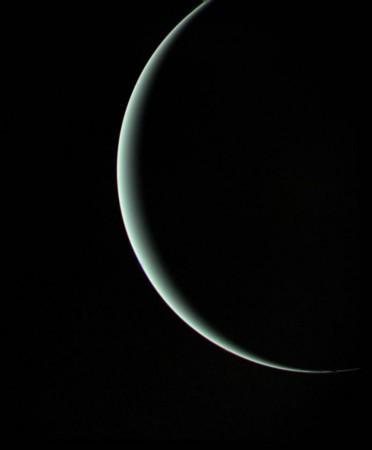
Uranus has a thick atmosphere that is populated by clouds made of hydrogen sulphide- the same gas that gives rotten eggs their signature smell. The presence of these smelly, large clouds was confirmed in a recent observation made by astronomers in Hawaii.
Hydrogen sulphide was detected in Uranus' cloud tops, reports the BBC. This discovery could open up several explanations as to how the outer planets were formed in the early days of the Solar System. Also, while there have been several past observations made of Uranus, including the Voyager 2 flyby, this is the first time that the composition of the planet is being decoded, noted the report.
So far, the debate has been around whether hydrogen sulphide or ammonia dominated the gas giant's atmosphere, but astronomers have finally settled it with this new finding, notes the report. Using the Near-Infrared Integral Field Spectrometer (NIFS) instrument on the Gemini North telescope on Hawaii's Mauna Kea summit, observations were made of Uranus, alongside analyzing the data collected, notes the report. Spectroscopic measurements work by breaking down infrared (IR) light from the source – Uranus– into component wavelengths.
Researchers then studied bands in resulting spectrum of IR known as absorption lines, where gases in the planet's atmosphere absorb IR light coming from the Sun. This allowed astronomers to accurately "fingerprint" components of Uranus' gases.

"Now, thanks to improved hydrogen sulphide absorption-line data and the wonderful Gemini spectra, we have the fingerprint which caught the culprit," said co-author Patrick Irwin, from the University of Oxford.
The abundance of hydrogen sulphide in the planet's atmosphere is in stark contrast to the composition of the Solar System's inner gas giants- namely, Jupiter and Saturn, notes the report. These planets have thick atmospheres filled with upper clouds of ammonia ice.
One of the reasons for these differences in atmospheric makeup, explains Dr Leigh Fletcher, from the University of Leicester, co-author of the study, is because of the way the planet formed and the conditions under which the planet was formed. As for the atmosphere of Uranus, he pointed out that when a cloud deck is formed by condensation, it tends to lock away the gas that formed the said cloud deep inside it, making it impossible to see with land-based telescopes, says the report.
"Only a tiny amount remains above the clouds as a saturated vapor... and this is why it is so challenging to capture the signatures of ammonia and hydrogen sulphide above cloud decks of Uranus," he said.
"The superior capabilities of Gemini finally gave us that lucky break."
This study was first published in the journal Nature Astronomy.







!['Abhishek will win national award': Abhishek Bachchan's poignant act will tug your heartstrings in slice of life emotional saga I Want To Talk [trailer review]](https://data1.ibtimes.co.in/en/full/805617/abhishek-will-win-national-award-abhishek-bachchans-poignant-act-will-tug-your-heartstrings.jpg?w=220&h=138)



